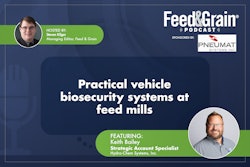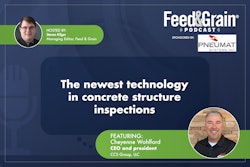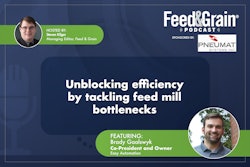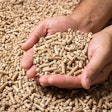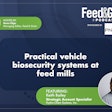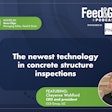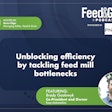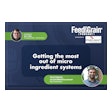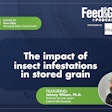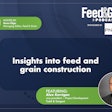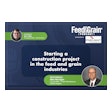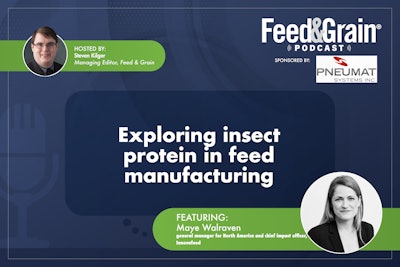
Tune into the latest episode of the Feed Grain Podcast where Steven Kilger discuss the groundbreaking work of Innovafeed in insect protein production. Our guest, Maye Walraven, general manager for North America and chief impact officer, dives into the details of their newly opened North American Innovation Center. Discover how insect protein is cultivated and its potential role in future feed formulations.
The transcript has been edited for clarity.
Steven Kilger - 00:00
Hi everyone, my name is Steven Kilger. I'm the managing editor of Feed & Grain Magazine and the host of the Feed & Grain Podcast. Thank you so much for joining me today as we dive deep into the issues affecting feed manufacturing, grain handling, and allied industries.
Today’s episode is brought to you by The BinWhip from Pneumat Systems. The powerful Dual Impact BinWhip removes the toughest buildup and blockages in industrial storage silos – without hazardous silo entry. Learn more today at binwhip.com.
In today’s episode, my guest is Maye Walraven, North America's General Manager and Chief Impact Officer at Innovafeed. Innovafeed recently opened its North American Innovation Center for insect protein, so she stopped by to talk about the innovation center, how cultivating insects for animal and pet feed works, and why it might fit into your future feed formulation plans.
I hope you enjoy the interview, if you want to help out with the podcast and are listening to this in a podcasting app please rate us and subscribe! If you’re listening online sign up for the Feed & Grain Newsletter Industry Watch to see the latest podcasts and stay up to date with all of the latest news from around the industry.
Now onto the show.
Hi Maye, thanks so much for joining me today.
Maye Walraven - 01:05
Hi Steven, thanks for having me.
Kilger - 01:12
Of course. Can you tell me a little bit more about yourself, and your background in the industry?
Walraven - 01:12
Sure. So I'm an engineer. I studied engineering and I specialized in environmental engineering, but quickly I found that a lot of the business people were making the decisions that would impact the environment. So I worked as a strategic consultant for a couple of years and then joined Innovafeed in 2017. So I didn't grow up wanting to grow insects, but in the end, It was a good fit in terms of the environmental impact it could deliver, which is what attracted me to this industry.
Innovafeed was founded in 2016 and the founders were looking for a way that they could impact positively the planet over the next decades. And they looked at different areas and they figured Feeding 10 billion people is going to be a huge challenge. If we want to do that sustainably, we're going to need to find very different ways of producing food that can leverage the resources we have and that is limited because we only have one planet and create more circularity so that all the waste that we are creating can be revalorized into new sources for food.
And so they looked at what options existed out there and a few people were starting to talk about insects in particular around that time the FAO released a white paper about the potential of insects and they figured well the idea is there but no one's done it at scale yet so how hard can it be? Turns out it's really hard.
Kilger - 03:00
The first time you do anything, it's, it's usually pretty hard. You guys are now kind of figuring it out at least. Can you talk a little bit more about the insect production?
Cause you guys do what black fly. It has a scientific name that I looked at multiple times and that just immediately went in one, you know, out of my head.
Walraven - 03:18
Yeah, the scientific name is Hermetia Illucens, so it's a very specific type of fly, not the house fly that people are used to. And the reason we selected that species, which as you said is also known as the black soldier fly, is for two main reasons.
First, it can feed on a very wide array of feedstock, which makes it very versatile.
You can grow it in different areas of the world based on different feedstock. And it converts that feedstock into very high-quality nutrients and so that was the second reason. When you look at the protein concentration it's very interesting because it's on par with most other animal proteins in terms of how balanced it is with its Amino acid profile in terms of how concentrated it is, but it's a lot more efficient as a source of protein because you need a lot less time and you need a lot less resource to produce the same quality protein, the same quality nutrients.
So we picked that insect after looking at a lot of different insects and also because, in terms of regulatory constraints, we're only allowed to raise insects that are non-invasive meaning that if they get released into the environment they won't take over the ecosystems and also they don't convey any diseases so unlike mosquitoes or some other insects they will not carry around different type of diseases.
Kilger - 04:46
Yeah. And from what I understand, like, I mean, they can eat just about anything, right? They can eat scraps and food waste and all these other things and produce a useful protein out of it, which seems like a kind of amazing kind of circular economy solution to, well, let's face it is already a huge amount of waste in this country. What does the end product look like? It's similar to what you'd see in soybean meal and stuff like that. I mean, it's not like you're getting, not like it looks like you're getting a big crate full of, you know, these flies at the end of the day. And how does it stack up nutritionally to something a little more, I guess I would say traditional?
Walraven - 05:21
Conventional source of protein. Yes. So the two main ingredients that we produce from our insects are a protein meal and an oil, kind of a source of fatty acid. The protein meal presents itself as a defatted and dehydrated powder. So if you look at it, it looks very much like cocoa powder, but it's closer in composition to, as you mentioned, either soy meal concentrate or fish meal or chicken meal which are quite conventional ingredients in animal feed and so we very much target the animal feed market with our ingredients.
But if you look at animal feed today it represents I think about half of the carbon emissions of the food and bev sector and something like 70% of arable land around the world is used to grow animal feed so Being able to find new sustainable sources of animal feed is going to be a game changer in terms of decarbonizing our food systems. The second ingredient is an insect oil. The property of this oil is that it's very rich in lauric acid, which is the main component of coconut oil. So similarly to coconut oil, it has some very nice antimicrobial properties, improves digestion, and kind of looks after the microbiome of animals. So we use it mostly for monogastric, so young piglets and chickens to improve their health performance.
Kilger - 06:54
I mean, 'cause it's being fed to animals, right? So we still get the benefits of having animal protein and a steak on your plate. And even though, you know, insects have been used for protein, human history. So, when you think about it for the modern consumer, there's a bit of an ick factor in there. Can you talk a little bit about the environmental and economic impacts of using it in animal feed instead of soy meal or something like that?
Walraven - 07:20
Yes, absolutely. So you have to think of insects as this super upcycle and that's their role in nature, right?
They're going to find sources of decomposing matter, low concentrated nutrients and they're going to concentrate it into this Kind of superfood. They do a good job of showing that in The Lion King with Pumbaa and Simba eating all these bugs and the magic is that they do that at a very low cost to the environment. And why is that?
Well, firstly, they're super efficient in how they transform The feedstock into biomass so usually you use feed conversion ratio to measure that our insect has a feed conversion ratio of about one to one versus a pig that has a feed conversion of four to one and so you need less resources to create the same amount of protein.
Walraven - 08:17
The second aspect is we've come up with a very unique way of growing insects where we co-locate our insect factories with large agricultural processing facilities. So in France, we work with a company called Terreaus and we've co-located our plant to one of their starch factory and we use the byproducts of that starch factory to feed our insects.
That way we avoid a lot of the drying that Would normally have to occur to sell these products on the feed market and these carbon economies can be of the tens of thousands of CO2 equivalent per year.
Similarly here in the US, the plan is to co-locate our insect factory with ADM's corn processing facility down in southern Illinois and therefore avoid that very energy-intensive drying step. So not only are the ingredients we provide a lot lower in terms of the carbon footprint, Two conventional sources of protein or fatty acids. But we're also avoiding all these carbon emissions in the value chains that we're operating in.
Kilger - 09:30
That's a really good point. There's no one solution for any of this carbon question. So it's those little things that add up and allow you to tell a story. And you guys have gotten partnerships with Cargill, and ADM now. I mean, there's a lot of really big names that are interested in your product. You just successfully commercialized your first additive to the pet food market and you have a pork supply chain that's done. It's a chicken one as well.
What's the plan for these? Especially because those are what is available in Europe, right? Is it planned to start introducing these in the US market?
Walraven - 10:05
Yeah so as I mentioned we have two main ingredients, our protein and our oil.
The protein we have two main markets, we have the pet food market which is generally replacing conventional ingredients like chicken meal. The advantage is it has a lower environmental footprint but also a lot of cats and dogs are overexposed to the same proteins all the time so having a diversity of protein can give them a healthier diet.
The other market we sell our protein in is the aquaculture market. So about half of our volumes go to the salmon industry and that's a very large industry in Europe, a little bit less in North America but you do have some aquaculture in Canada, in the US. So that's why in the US we very much focus on pet food and in Europe, we're very focused on aquaculture.
And then our second product, the insect oil, goes towards poultry and swine, which is a huge market in the United States. At the moment we're still waiting for some regulatory approval from AFCO, which, fingers crossed, should come later this year, especially for the chicken market. But we see huge potential for these ingredients here in North America.
Kilger - 11:25
Yeah, especially because aquaculture is going to be the industry that grows over the next 10, or 20 years here in America. I think as we kind of, well, we all have to accept that we can't just keep fishing our oceans.
So what are some of the big challenges you guys are facing regulatoryly? I mean, AFCO, obviously any other big steps in kind of the acceptance and regulatory landscape here in America?
Walraven - 11:51
Well, I think we're in a good spot when it comes to feed regulation. So most of the main PCs have either been approved or are in the process of being approved. And then once we meet a certain threshold of species, we'll get an all-species approval. So we've been working as an industry with other insect players to get those approvals across the line.
Another topic of interest to us is getting organic certification so that's something that as an industry we're working on at the moment because a lot of the ingredients that we're competing with have organic certification but sometimes like fish meal doesn't come from an organically grown animal it comes from wild resources. So there is a question of where insects fit in the organic landscape.
Kilger - 12:47
Yeah, definitely. I'm sure. So you guys just opened up your North American Insect Innovation Center. Can you tell me a little bit about it and what it represents to you and your company? And because I've seen, seen videos and things about how these facilities work and they're kind of amazing. They're probably the most high-tech facilities we have in kind of this animal ag protein space. So they're cool with how they work. Can you explain a little bit more about it and how all that's going down?
Walraven - 13:17
Sure, so the way we grow our insects you kind of have to think about it as an Amazon storage center. But we don't store parcels we store insects and we let them grow but a lot of the moving around the insects is done by robot and automatically a lot of the managing the environmental conditions is done through thousands of sensors and data that is analyzed by AI. So it is quite technical environment and with that comes you know fairly large CapEx with every plant that we invest in and therefore we want to make sure before we build a new plant we de-risk significantly what the local conditions are.
Here in the US we would be switching feedstock we're going to be using corn-based by-product and in Europe we're using wheat-based so really the innovation center is going to give us the ability to test this new source of feedstock, make sure we reach the same performance or better and also test some environmental factors in the midwest. The weather can be a little bit more extreme than it is in France so making sure we're equipped To face those new challenges in this new geography. So the Innovation Center is giving us the opportunity for a trial and error before we build a much larger plant.
Kilger - 14:41
Yeah. Well, I've seen the plants too. I mean, it's, you know, like you said, it looks like almost an Amazon warehouse and I'm glad robots do it. Cause I wouldn't want to be that person that, you know, is responsible for drawing a giant box full of black soldier flies. It's got to be a nightmare to clean up. So yeah, I'm glad the robots are doing it.
Walraven - 15:00
A little bit like the fear factor.
Kilger - 15:03
Exactly. Well, where can people find out more information about Innova feeds and what you're up to?
Walraven - 15:10
Sure we have a website that explains a little bit about our production model, and our ingredients, and you go on LinkedIn. We try to be active in posting about the latest developments and the latest exciting news. So follow us on LinkedIn.
Kilger - 15:27
Excellent. Well, thank you so much for stopping by and talking with me today. I appreciate it.
Walraven - 15:35
Well, thanks. I appreciate your interest in our emerging industry and all the exciting
Kilger- 15:50
Thank you for joining me, everyone out there listening, thank you so much for being a listener, and make sure you stay safe out there.
.jpg?auto=format%2Ccompress&crop=faces&fit=crop&h=48&q=70&w=48)


